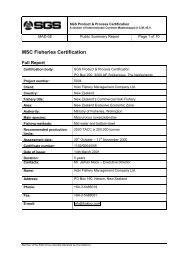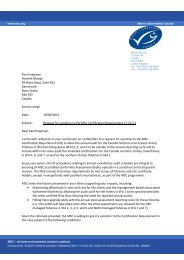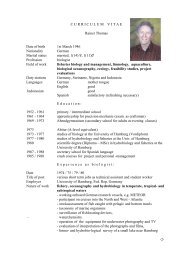SGS Product & Process Certification - Marine Stewardship Council
SGS Product & Process Certification - Marine Stewardship Council
SGS Product & Process Certification - Marine Stewardship Council
You also want an ePaper? Increase the reach of your titles
YUMPU automatically turns print PDFs into web optimized ePapers that Google loves.
APPENDIX D: STAKEHOLDER COMMENTS<br />
(includes all written and verbal communication)<br />
Received from: Jan Willem Wijnstroom, Sportvisserij Nederland, Royal Dutch Angling<br />
Association<br />
May 18 th 2010<br />
Bass is a prime target species for recreational anglers in the Netherlands, UK, Belgium and<br />
France. Bassfishing has gained a lot of popularity during the last 20 years. Due to the decline of<br />
flatfish, cod and eel stocks the range of fishing possibilities also declined: the increase in bass<br />
fishing possibilities provides the Dutch recreational angling sector with new opportunities.<br />
Estimated number of bass anglers in the Netherlands in 2006 was 91.000 (TNS NIPO 2006). More<br />
than 50 % of Dutch bass anglers advocate improved bass stock management. Commercial<br />
fishermen need to take part in this management.<br />
Recreational bass angling in Holland has a calculated socio economic value of 15,8 bilj euro on a<br />
yearly basis.<br />
Recreational bass anglers and commercial anglers (VBHL) fish for the same species and thus<br />
there is common interest in a management system that benefits better management of bass and<br />
other marine resources and in which the interests of both stakeholders are being taken care of.<br />
PI Comment<br />
1.1.1 There are very little scientific research data available on<br />
eastern North sea bass populations. General perception<br />
amongst recreational anglers as well as members of VBHL<br />
is that mature and bigger bass are getting scarcer. There is<br />
a steady decline in the stamp of bass available to<br />
recreational anglers and other metiers like commercial rod<br />
and line fishermen.<br />
1.1.2 Explicit (formal) reference points have not yet been defined<br />
for the bass stocks in ICES Area IV. A main assessment<br />
using the default assessment tree would very likely result in<br />
a score below the unconditional level but above the minimal<br />
level. It is likely that this performance indicator will attract a<br />
condition that requires the client to liaise with Research<br />
Bodies (IMARES, CEFAS) and have a part in the further<br />
development of appropriate reference points for the North<br />
Sea stock.<br />
1.2.2 The mls for sea bass (36 cm) is considered to be too low.<br />
Sportvisserij Nederland advocates an mls increase to 42<br />
cm , to give bass the opportunity to grow and to spawn.<br />
Although occasionally mature bass are found at 36 cm, we<br />
advocate that the whole fishery is subject to measures that<br />
protect undersized bass. VBHL fishermen apply a bigger<br />
mls which is the right step in the direction.<br />
Page 147 of 151





